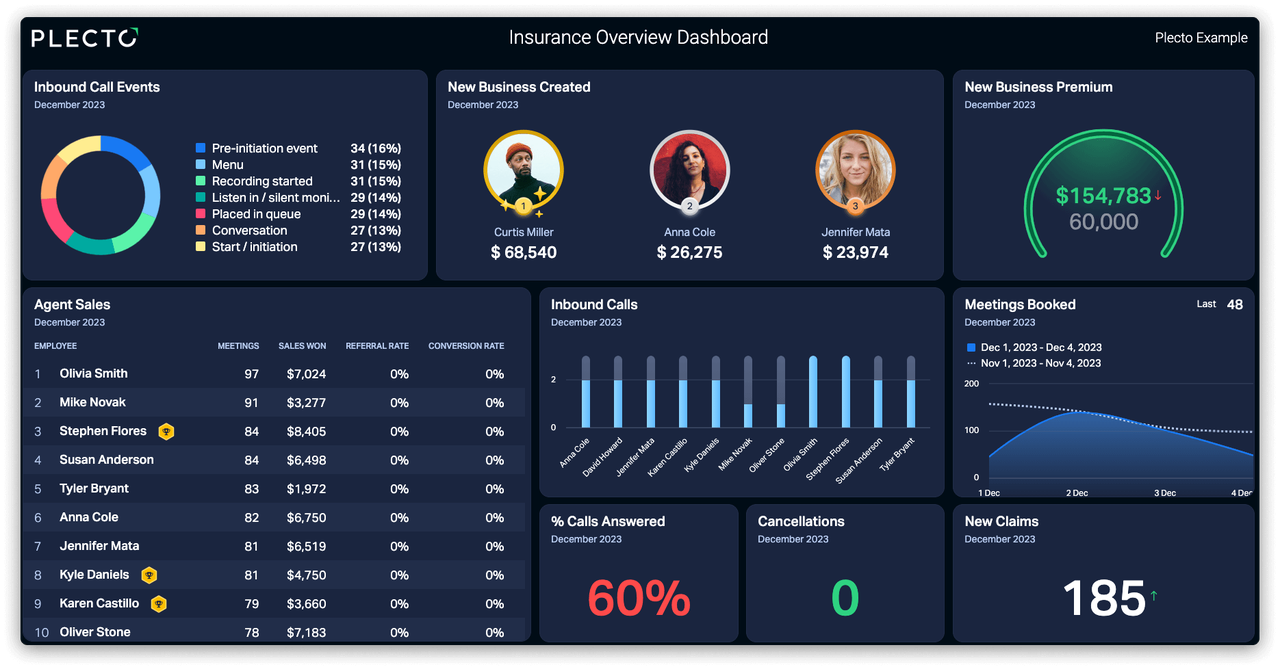Insurance is one of the world’s most data-driven industries, but it might come as a surprise that the industry’s use of data analytics extends well beyond the actuarial department. Thanks to modern technology, which makes data more accessible than ever before, insurance companies are using data to look ahead and glean insights into process optimization, maintain comprehensive overviews of their business, reduce risk, drive business decisions, and more!
In this article, we’ll explore five key benefits of data analytics for insurance companies.
What is insurance data analytics?
Insurance data analytics is the collection and analysis of insurance-related data to mine actionable insights that can help drive business decisions. Data and analytics have driven pricing and claims-related business decisions for decades. Now with the proliferation of big data, more and more insurance companies are mining and using this data to predict what will happen to their businesses in the future—and to drive decisions that will positively affect these outcomes.
In 2021, insurance companies invested $3.6 billion in big data analytics. In return, they’ve seen a 30% increase in efficiency, 40–70% cost savings, and a 60% increase in fraud detection rates. The insurance industry is a leader in the use of big data analytics and now uses this information at almost every stage of its everyday operations.
5 Key Benefits of Data Analytics in Insurance
Managing risk while offering competitive policies is one of the main drivers of using data analytics for insurance. Many insurance companies offer a variety of insurance products covering everything from cars and property to health and long-term care—each with its own risk profile. Regardless of which products they offer, all insurance companies seek to reduce costs, increase profit, and build lasting customer relationships—and many rely on data-driven predictive analysis to make sound business decisions that support these goals.
While insurance analytics can improve the efficiency of claims, policy, and sales processes, that’s just the tip of the iceberg. Read on to learn five key benefits of data analytics for insurance.
1. Lead Generation
There are a lot of challenges out there for lead generation insurance companies. Watching the competition and taking the lead on the market, bringing in high-intent insurance leads, and always having excellent customer service, just to name a few of the challenges lead generation companies are facing. Data analysis helps in many different ways to solve those problems. First and foremost, data analysis gives marketers and insurers a clear understanding of their Customer Acquisition Cost or CAC, displaying how much is spent on organic lead generation and third-party vendors. The end result of this is that it puts out a clear view of where companies should invest their resources.
How to generate organic insurance leads
You will start by using data analytics to find out what your perfect leads look like and how and where to find people that fit into that. While many companies have viewed this as a disadvantage, others have seen it as an opportunity. Many CRMs and agency management systems provide the capability to segment customers by correlating customers’ search data with their buying patterns to better understand the customer journey. This enables marketing departments to target leads with the right information at the right time via the right channel. A pro-tip for insurance companies would be to use predictive analytics, which can help them set up future steps in the lead generation process. These are the usual tactics used to generate organic insurance leads:
- Positive client reviews on their own website as well as review sites
- Word of mouth → asking existing clients to recommend you. You could even start a referral program!
- Investing in content marketing
- Networking! Both online and offline in order to make an organic lead generation pool.
Online self-service quoting tools have disrupted the usual insurance sales process, which has traditionally been high-touch and based on long-term relationships between insurance agents and the people they insure.
2. Better Customer Satisfaction
According to McKinsey, insurance companies that offer best-in-class customer experiences are 80% more likely to retain customers than companies that don't. In addition, they’re more likely to successfully cross-sell and receive referrals, which can significantly reduce marketing and customer acquisition costs.
Insurance companies have caught wind of these benefits and have begun analyzing data trends in an effort to predict their customers’ needs. This makes it easier to provide support, suggest relevant products, and close sales. Using data analytics to uncover customers’ most common support inquiries enables insurance companies to provide comprehensive self-service tools that provide around-the-clock support and boost customer satisfaction scores.
Companies that can accurately predict their customers’ needs, whether it’s support or a particular product, are more likely to exceed expectations and reap the rewards.

Build your first dashboard.
Start your 14-day free trial today
3. Less Fraud
Claims fraud has always been one of the biggest challenges facing the insurance industry. In the United States alone, fraudulent claims cost at least $80 billion per year —an estimated 10% of all payouts. Fortunately, recent advances in insurance administration solutions and data analytics have yielded significant improvements to fraud-detection processes.
Data analytics in insurance makes fraud-detection processes faster and more accurate. Analytics make it easier to spot trends while advanced analytics and predictive modeling use historical data (e.g., past claims, frequency of claims) and externally sourced information (e.g., credit scores) to flag claims with a high probability of being fraudulent. These data analytics have become so advanced that some predictive analysis models can even pinpoint customers who are most likely to submit fraudulent claims, empowering insurers to take preventative measures before they’re taken for a ride.
4. Faster Underwriting
Underwriting has long been one of the most complicated aspects of the insurance business because while the stakes were high, it was largely based on intuition and guesswork. Data analytics for insurance are changing this by using predictive trend data to produce comprehensive risk assessments. These assessments reduce the time burden of manually assessing risk profiles while improving underwriters’ ability to set premiums that accurately reflect each policyholder’s level of risk.
Accurately assessing customers’ risk profiles ensures fair pricing for everyone while automating the most time-consuming part of the process makes it less likely that another company will make an offer first. Long underwriting times increase the chances that a customer will sign with another company in the meantime, resulting in lost revenue and sunk costs.
5. Business Growth
The intelligent and ongoing use of data analytics should culminate in business growth. Targeted marketing messages, better customer satisfaction, less fraud, and faster underwriting can only translate into improved revenue. By selling more effectively, cutting fraud-related costs, and improving risk assessment, companies that choose to harness the power of insurance data analytics improve their bottom line. Predictive analytics, in particular, can help companies identify money pits and mitigate them before they get out of hand.
Insurance Data Visualization for Data-Driven Decisions
There’s little doubt that data analytics for insurance can increase profitability. To reap the full benefits of big data, many companies visualize their data in real-time dashboards and reports.
Insurance data visualization tools, like Plecto, provide set-and-save reports that automatically distill complex data into visual formats that make it easier to share and understand. Automated reporting ensures that you always have the most up-to-date information—and Plecto even lets you export your data to PowerPoint or Excel in just a few clicks.
Plecto’s digital insurance toolbox has been shown to supercharge performance by up to 25%. Sign up for a free 14-day trial and see how Plecto can help you visualize your insurance data analytics to improve the efficiency of claims, policy and sales processes efficiency—and more—all though the power of data!




